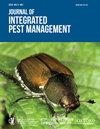Insect Pathogenic Fungi for Biocontrol of Plague Vector Fleas: A Review
IF 2.7
3区 农林科学
Q1 ENTOMOLOGY
引用次数: 4
Abstract
Bubonic plague is a lethal bacterial disease of great historical importance. The plague organism, Yersinia pestis, is primarily transmitted by fleas (Siphonaptera). In natural settings, where its range expands, Y. pestis resides in association with wild rodents and their fleas (sylvatic plague). While chemical insecticides are used against plague vector fleas, biological approaches have not been as critically evaluated. Benign and cost-effective control methods are sorely needed, particularly where imperiled species are at risk. Here we explore the potential of two representative insect pathogenic fungi, Beauveria bassiana Vuillemin 1912 (Hypocreales: Cordycipitaceae) and Metarhizium anisopliae Metschnikoff 1879 (Hypocreales: Clavicipitaceae), each already used commercially worldwide in large-scale agricultural applications, as candidate biopesticides for application against fleas. We review the life cycles, flea virulence, commercial production, and field application of these fungi, and ecological and safety considerations. Pathogenic fungi infections among natural flea populations suggest that conditions within at least some rodent burrows are favorable, and laboratory studies demonstrate lethality of these fungi to at least some representative flea species. Continued study and advancements with these fungi, under appropriate safety measures, may allow for effective biocontrol of plague vector fleas to protect imperiled species, decrease plague outbreaks in key rodent species, and limit plague in humans.昆虫病原真菌防治鼠疫媒介跳蚤的研究进展
Bubonic瘟疫是一种具有重大历史意义的致命细菌性疾病。鼠疫菌主要通过跳蚤传播。在范围扩大的自然环境中,鼠疫杆菌与野生啮齿动物及其跳蚤(森林鼠疫)共存。虽然化学杀虫剂被用于对付鼠疫媒介跳蚤,但生物学方法尚未得到严格评估。迫切需要良性和具有成本效益的控制方法,尤其是在濒危物种面临风险的情况下。在这里,我们探索了两种具有代表性的昆虫病原真菌的潜力,即球孢白僵菌1912(Hypocreales:Cordycipitaceae)和绿僵菌Metschnikoff 1879(Hypocreales:Clavicipitaceae。我们综述了这些真菌的生命周期、跳蚤毒力、商业生产和现场应用,以及生态和安全考虑。自然跳蚤种群中的病原真菌感染表明,至少一些啮齿动物洞穴内的条件是有利的,实验室研究表明,这些真菌对至少一些有代表性的跳蚤物种具有致命性。在适当的安全措施下,对这些真菌的持续研究和进步,可能有助于对鼠疫媒介跳蚤进行有效的生物控制,以保护濒危物种,减少主要啮齿动物物种的鼠疫爆发,并限制人类的鼠疫。
本文章由计算机程序翻译,如有差异,请以英文原文为准。
求助全文
约1分钟内获得全文
求助全文
来源期刊

Journal of Integrated Pest Management
Agricultural and Biological Sciences-Insect Science
CiteScore
5.80
自引率
3.60%
发文量
24
审稿时长
25 weeks
期刊介绍:
Journal of Integrated Pest Management is an open access, peer-reviewed, extension journal covering the field of integrated pest management. The Editors-in-Chief are Dr. Marlin E. Rice (formerly with Iowa State University) and Dr. Kevin L. Steffey (formerly with the University of Illinois). The journal is multi-disciplinary in scope, publishing articles in all pest management disciplines, including entomology, nematology, plant pathology, weed science, and other subject areas.
 求助内容:
求助内容: 应助结果提醒方式:
应助结果提醒方式:


